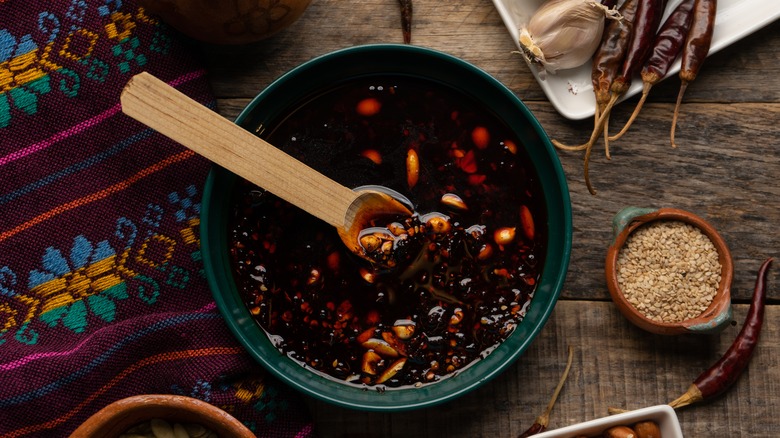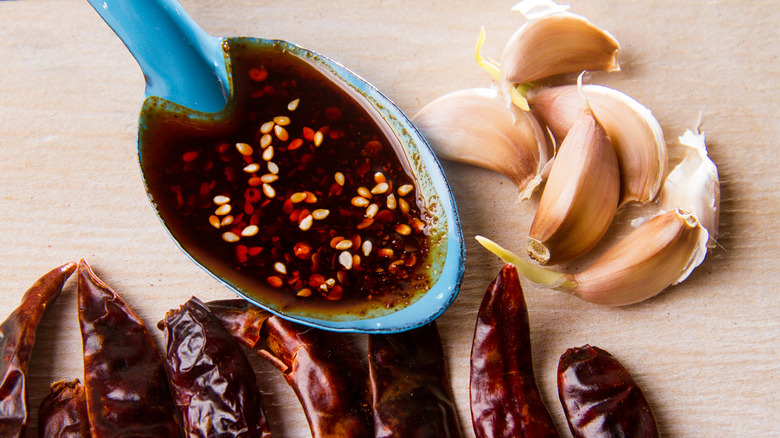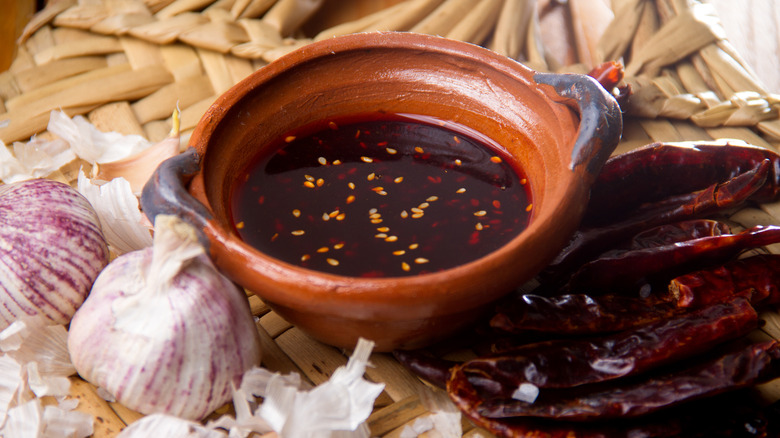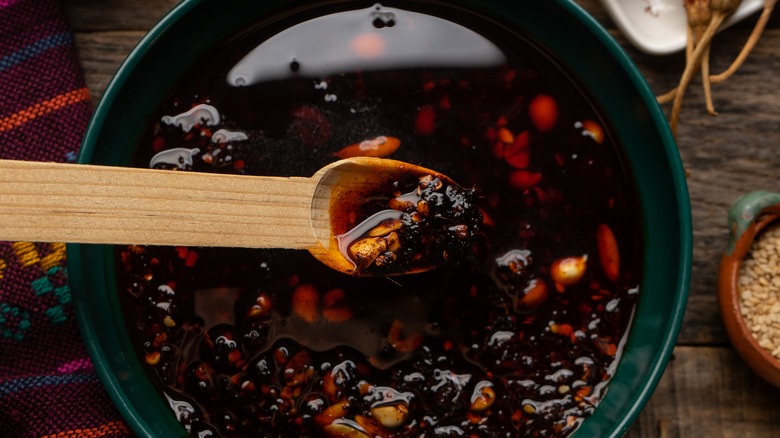The Key Differences Between Salsa Seca And Macha
Few nations contain a varied — and delicious — assortment of regional cuisines quite like Mexico's. From the well-preserved indigenous techniques in Oaxaca to the internationally influenced cuisine of Veracruz, a dizzying medley of cultures, traditions, and pride have fused into ancestral techniques. As a result, just about every part of the country boasts its own quintessential creation, whether it's birria in Guadalajara or cochinita pibil in the Yucatan.
As a result, this makes pinpointing the origins of noted culinary creations straightforward; however, less-famed dishes may slip through the cracks. Take the country's oil-based condiments: salsa seca and salsa macha. The former remains a relatively obscure creation, often referred to colloquially and without a set recipe. Meanwhile, the latter is becoming one of the nation's most noted new culinary exports, boosted by the popularity of Oaxacan cuisine.
Many chefs are working to promote lesser-known techniques and ingredients while simultaneously celebrating classics in Mexico. Sampling both the famed hits and obscure dishes, chefs have shown that all techniques deserve a place on the table. So, let's dive into the distinctions between these two oil-based salsas; their relationship reveals the breadth of Mexican cuisine.
What is salsa seca?
Salsa seca — which translates to "dry salsa" — refers to a broad range of oil-based condiments. Many contain an extensive list of components, including seeds, nuts, aromatics such as garlic and onion, as well as peppers. However, salsa seca also encompasses more straightforward chile-oil-like creations, which can be as simple as oil mixed with dried peppers and garlic.
No matter the components, the sauce is created by frying the ingredients in oil. Next, the elements are either blended together or, more traditionally, pounded by hand in a molcajete. Most renditions keep the result paste-like, drizzling in just a bit of the utilized frying oil, while others create a more liquid consistency. Some versions can even use tomatoes — which are toasted — lending it a character similar to other salsas. Such is the quality of the sauce; it doesn't have a defined array of components and texture. In addition to being a delicious tableside condiment, it's frequently employed to cook pork, with the peppery seasoning infusing the meat. Salsa seca showcases the deliciousness and malleability of oil-based sauces.
What is salsa macha?
Unlike the more expansive salsa seca, salsa macha's origin is traced specifically to the town of Orizaba, Veracruz. The condiment is defined by a lack of tomatoes or tomatillos, instead utilizing oil as a liquid base. Nuts and seeds — especially peanuts and sesame seeds — are commonly toasted and ground into the sauce, or kept whole. And like other salsas, dried peppers are an indispensable addition, too.
Salsa macha typically runs spicy, accentuated by additions like árbol peppers, however, its foundational base is the earthier ancho and pasilla peppers. Adding garlic enhances its savory character. For a hint of tang, many preparations also call for a spoonful or two of vinegar. However, to contrast the bright tang and heat of fresh salsas, macha's aim is to deliver a rich combination of smokey and earthy flavors. Its lack of raw vegetables, combined with high oil content, ensures stability without refrigeration. In recent years, the condiment's versatility and ease of use have increased its popularity in the U.S., leading to a variety of packaged varieties.
Salsa seca refers to a broad range of condiments that includes salsa macha
Salsa macha's popularity — both within Mexico and abroad — has made it the iconic exemplar of oil-based salsas. However, it's a subtype of salsa seca, which expands the category to condiments that employ tomatoes, onions, and other raw ingredients in an oil base. While there are versions of salsa macha sans nuts, their body and flavor are intertwined with the condiment's creation. Conversely, salsa seca has more frequent renditions with peppers and oil — it's a more open-ended category.
Additionally, salsa macha's strong intertwining with the culinary traditions of Veracruz and Oaxaca likely further defined its identity. Salsa seca exists in a greater assortment of regions — such as Michoacán — which complicates its origin story. The condiment showcases the malleable and ever-expansive nature of Mexican cuisine. While the famed versions are delicious and well-known for good reason, there are always more types to discover. So feel free to experiment and tweak the delicious oil-based condiments to personal taste.



